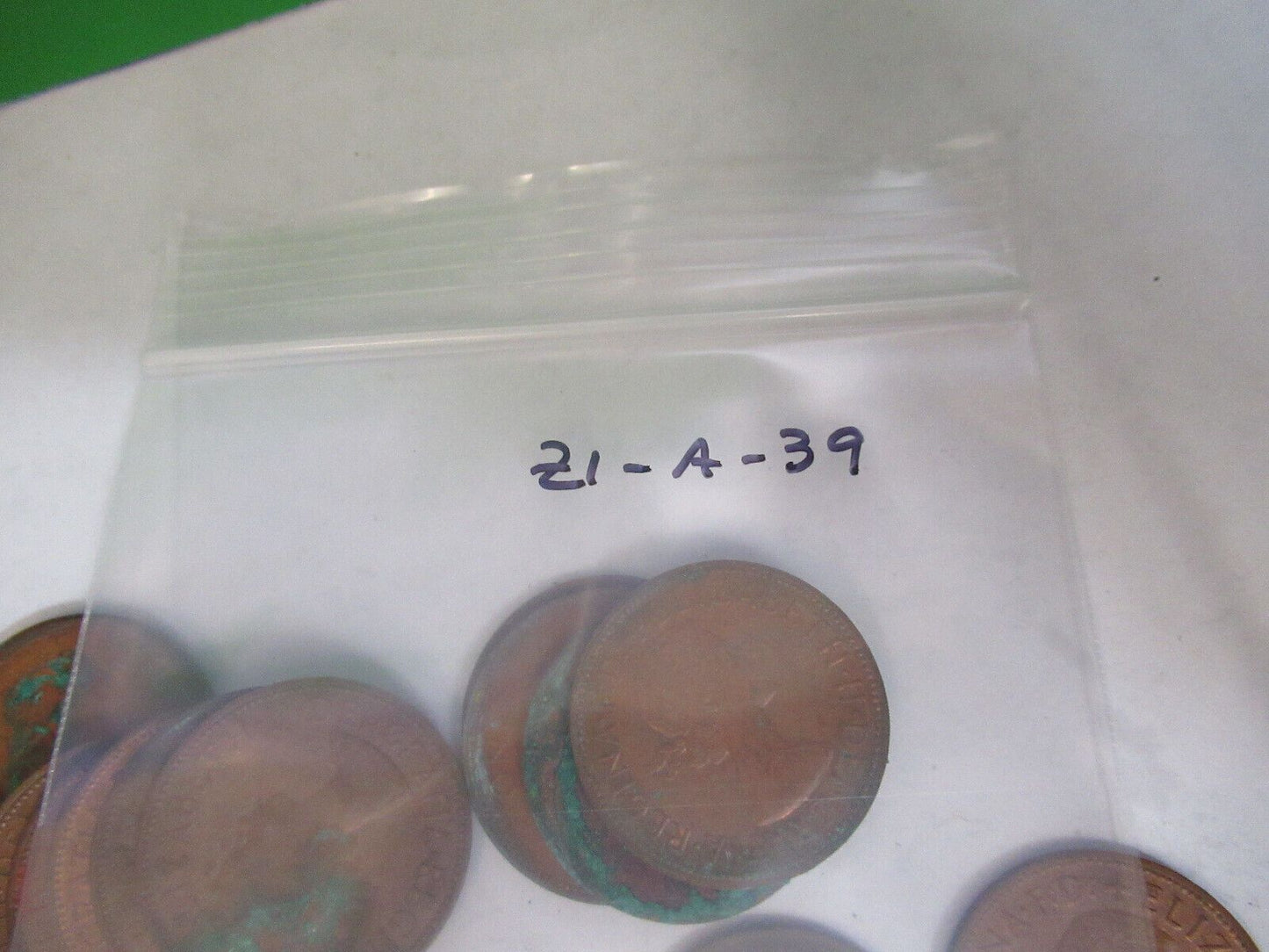
This set of British pennies hearkens back to a not so distant time when the economy of the United Kingdom was still founded on a pre-decimal system of accounting, one that traced its origins all the way to the Middle Ages. This set includes fourteen Queen Elizabeth II pennies, all stamped in 1964 and a single George V penny, stamped in 1918.
The markings are described in the table below:
| Coin | Obverse Lettering | Full Text | Reverse Lettering |
| Queen Elizabeth II | ELIZABETH·II·DEI· GRATIA·REGINA·F:D: | Elizabeth II Dei Gratia Regina Fidei Defensatrix | ONE PENNY 1964 |
| King George V | GEORGIVS V DEI GRA:BRITT:OMN:REX FID:DEF:IND:IMP: | Georgius V Dei Gratia Britanniarum Omnium Rex Fidei Defensor Indiae Imperator | ONE PENNY 1918 |
The British Pre-Decimal System
The pre-decimal system refers to an antiquated organization of British currency whereby, instead of being founded on a base ten organization (such that 100 pence yield one pound), the fundamental British monetary units were fixed at a 12:20 ratio, that is, 12 pence per shilling, 20 shillings per pound, 240 pence altogether to yield a pound. This system was derived from currency reorganization efforts undertaken during the Carolingian period across Western Europe. These efforts themselves trace back a Roman lineage, with the names penny and shilling representing later renamings of the original denarii and solidi. The system would remain in place in England and a significant portion of Western Europe for hundreds of years.
The use of pre-decimal systems of currency quite commonly operated on the base value of the metal contained within the coins themselves, hence, the history of currency reform frequently ties together with the history of weight and measurement reform. Coins being physically worth their weight helped assure their value, especially during uncertain times. Accordingly, coin exchange rates were liable to change depending on the economic fluctuations of their constituent materials. Still, some pre-modern states attempted to use a decimal system for their currency, namely China in the 1st century CE, though the reform did not last long. The first state to establish decimalized currency and maintain it was Russia in 1704 under the reforms of Peter the Great whereby the Russian ruble became comprised of 100 kopeks.
The first concerted efforts to bring England's system of currency to a decimal standard began in the 17th century along with more general efforts to decimalize systems of measurement. Though these efforts would not be successful, the sentiment they echoed would find form in the foundation of American currency on the decimal system in 1792, exchanging 100 cents per Spanish dollar; also known as the piece of eight or real de a ocho, the silver Spanish dollar was a leading currency of exchange during the 18th century, especially in colonial America. Amidst the metrication efforts of the French Revolution, France would also convert to a decimal currency system during this time, diffusing the practice across Europe following the French conquests of the Napoleonic period. Still, throughout the 19th century, despite various parliamentary debates, the British government resisted the change. In 1847, the currency decimalization movement in the United Kingdom shifted marginally in favor of the decimalists with the creation of the British florin, a coin designated as 1⁄10 of a shilling and intended to be an intermediary step before overall transition. Prominent proponent of the florin, Sir John Bowring notably remarked on decimalization in a motion before Parliament that, "every man who looked at his ten fingers, saw an argument for its use, and an evidence of its practicability." Nonetheless, the florin proved initially unpopular, and, even amidst later acceptance did not develop the necessary momentum to drive an overall change towards decimalization. Reports from the Royal Commission on Decimal Coinage from 1857-1859 highlight specific doubts amongst members of the British government that the success of decimal coinage in foreign countries would be particularly comparable to the British market or that the British public would even accept such a change should the British government opt to make it. Regardless, the issue of decimalization would remain relatively unchanged for almost a century.
Perhaps the largest driving force for decimalization finally arrived in the 1960s with the change in global economic circumstance following the Second World War. Amidst widespread decolonization and increasing global interconnectedness, many countries, including virtually all of the United Kingdom's former colonies began to transition to decimal systems of currency. By remaining fixed to the 12:20:240 ratio, the United Kingdom was becoming one of the last countries in the world, and by far, the largest economy, to still rely on pre-decimal currency. The matter of decimalization had finally become one of genuine importance to British business and general public interest, and hence, developed the political impetus to have decimalization approved by Parliament with the Decimal Currency Act of 1967.
The date was set and on Monday, February 15, 1971, Decimal Day, also often called D Day in the press, the United Kingdom successfully transitioned from the old British pound sterling to the new, decimalized pound that it uses to this day.
Bibliography
- Cribb, Joe, Barrie Cook and Ian Carradice. The Coin Atlas: The World of Coinage from Its Origins to the Present Day. New York: Macdonald & Co, 1990.
- Moore, N. E. A. The Decimalisation of Britain's Currency. London: Her Majesty's Stationery Office, 1973.
- Naismith, Rory. Making Money in the Early Middle Ages. Princeton: Princeton University Press, 2023.












